英语的连读吞音技巧
英语连读的方法
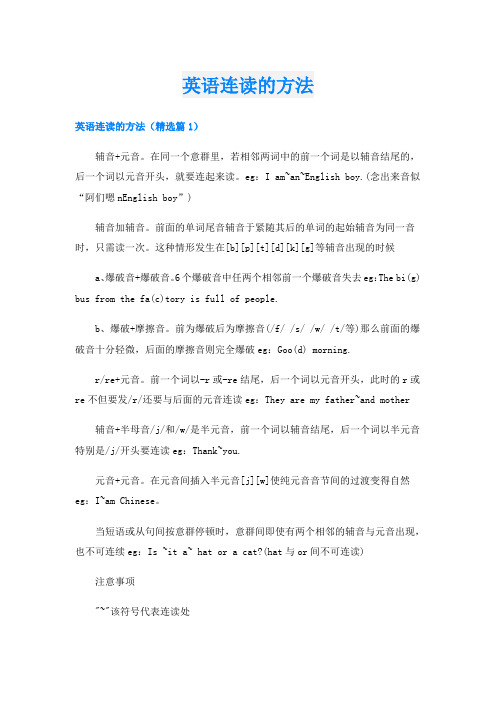
英语连读的方法英语连读的方法(精选篇1)辅音+元音。
在同一个意群里,若相邻两词中的前一个词是以辅音结尾的,后一个词以元音开头,就要连起来读。
eg:I am~an~English boy.(念出来音似“阿们嗯nEnglish boy”)辅音加辅音。
前面的单词尾音辅音于紧随其后的单词的起始辅音为同一音时,只需读一次。
这种情形发生在[b][p][t][d][k][g]等辅音出现的时候a、爆破音+爆破音。
6个爆破音中任两个相邻前一个爆破音失去eg:The bi(g) bus from the fa(c)tory is full of people.b、爆破+摩擦音。
前为爆破后为摩擦音(/f/ /s/ /w/ /t/等)那么前面的爆破音十分轻微,后面的摩擦音则完全爆破eg:Goo(d) morning.r/re+元音。
前一个词以-r或-re结尾,后一个词以元音开头,此时的r或re不但要发/r/还要与后面的元音连读eg:They are my father~and mother 辅音+半母音/j/和/w/是半元音,前一个词以辅音结尾,后一个词以半元音特别是/j/开头要连读eg:Thank~you.元音+元音。
在元音间插入半元音[j][w]使纯元音音节间的过渡变得自然eg:I~am Chinese。
当短语或从句间按意群停顿时,意群间即使有两个相邻的辅音与元音出现,也不可连续eg:Is ~it a~ hat or a cat?(hat与or间不可连读) 注意事项"~"该符号代表连读处“()”中为失去爆破音若一个音节后有r,即使后面的词以元音开头也不连读eg:nearer and nearer不连读英语连读的方法(精选篇2)1、相邻的词中,前一个词的末尾是辅音,后一个词的开头是元音 Take a look at it I’ll be back in half an hour. Will it take a lot of time to go totown on foot?2、为使说话流畅,词末元音可以和词首元音连读,而不停顿。
详解:连读、吞音、不发音、失去爆破!
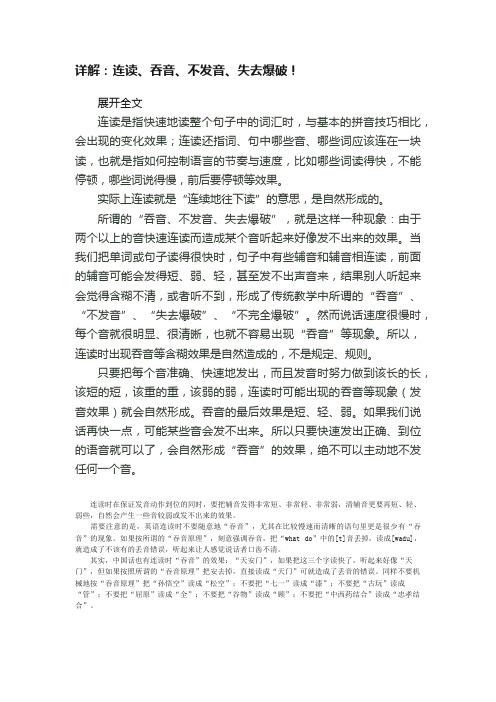
详解:连读、吞音、不发音、失去爆破!展开全文连读是指快速地读整个句子中的词汇时,与基本的拼音技巧相比,会出现的变化效果;连读还指词、句中哪些音、哪些词应该连在一块读,也就是指如何控制语言的节奏与速度,比如哪些词读得快,不能停顿,哪些词说得慢,前后要停顿等效果。
实际上连读就是“连续地往下读”的意思,是自然形成的。
所谓的“吞音、不发音、失去爆破”,就是这样一种现象:由于两个以上的音快速连读而造成某个音听起来好像发不出来的效果。
当我们把单词或句子读得很快时,句子中有些辅音和辅音相连读,前面的辅音可能会发得短、弱、轻,甚至发不出声音来,结果别人听起来会觉得含糊不清,或者听不到,形成了传统教学中所谓的“吞音”、“不发音”、“失去爆破”、“不完全爆破”。
然而说话速度很慢时,每个音就很明显、很清晰,也就不容易出现“吞音”等现象。
所以,连读时出现吞音等含糊效果是自然造成的,不是规定、规则。
只要把每个音准确、快速地发出,而且发音时努力做到该长的长,该短的短,该重的重,该弱的弱,连读时可能出现的吞音等现象(发音效果)就会自然形成。
吞音的最后效果是短、轻、弱。
如果我们说话再快一点,可能某些音会发不出来。
所以只要快速发出正确、到位的语音就可以了,会自然形成“吞音”的效果,绝不可以主动地不发任何一个音。
连读时在保证发音动作到位的同时,要把辅音发得非常短、非常轻、非常弱,清辅音更要再短、轻、弱些,自然会产生一些音较弱或发不出来的效果。
需要注意的是,英语连读时不要随意地“吞音”,尤其在比较慢速而清晰的语句里更是很少有“吞音”的现象。
如果按所谓的“吞音原理”,刻意强调吞音,把“what do”中的[t]音丢掉,读成[wadu],就造成了不该有的丢音错误,听起来让人感觉说话者口齿不清。
其实,中国话也有连读时“吞音”的效果:“天安门”,如果把这三个字读快了,听起来好像“天门”,但如果按照所谓的“吞音原理”把安去掉,直接读成“天门”可就造成了丢音的错误。
英语中的吞音现象
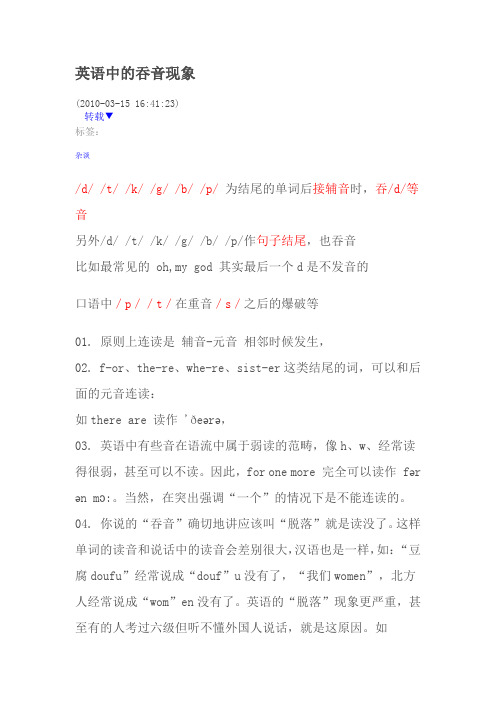
英语中的吞音现象(2010-03-15 16:41:23)转载▼标签:杂谈/d/ /t/ /k/ /g/ /b/ /p/为结尾的单词后接辅音时,吞/d/等音另外/d/ /t/ /k/ /g/ /b/ /p/作句子结尾,也吞音比如最常见的 oh,my god 其实最后一个d是不发音的口语中/p//t/在重音/s/之后的爆破等01. 原则上连读是辅音-元音相邻时候发生,02. f-or、the-re、whe-re、sist-er这类结尾的词,可以和后面的元音连读:如there are 读作'ðeərə,03. 英语中有些音在语流中属于弱读的范畴,像h、w、经常读得很弱,甚至可以不读。
因此,for one more 完全可以读作 fər ən mɔ:。
当然,在突出强调“一个”的情况下是不能连读的。
04. 你说的“吞音”确切地讲应该叫“脱落”就是读没了。
这样单词的读音和说话中的读音会差别很大,汉语也是一样,如:“豆腐doufu”经常说成“douf”u没有了,“我们women”,北方人经常说成“wom”en没有了。
英语的“脱落”现象更严重,甚至有的人考过六级但听不懂外国人说话,就是这原因。
如“there's a”经常说成“ðəzə”弱化了;go for a walk读成[gəu f ə wɔ:lk]甚至读成[gəu f wɔ:lk]都有不同程度的脱落现象。
05. 爆破:两个爆破音相邻,前面的不发音,只是停顿一下,叫完全失去爆破,如:peak park读作[pi:(k) pa:k]。
爆破音后面跟着辅音,使爆破音读的很轻,叫不完全失去爆破,如bedroom读作[be(d)ru:m]这里d读的很轻。
● 爆破在英语里很重要,直接影响说话的流畅程度。
吞音是指两个相邻的词连读,在某种情况下有些音省掉不发,这是标准英语口语的重要技巧。
native speaker有很多约定俗成的连读规则,其中就包括吞音,目的是为了让说话更流畅。
音标连读发音规律总结

音标连读发音规律总结一、连读简介在英语口语中,连读是一种常见的发音现象。
它是指两个或多个相邻的音素之间产生自然的滑动,形成一个新的语音单位。
连读可以增强口语的自然流畅度,但对于初学者来说,正确掌握并运用它却并不容易。
二、连读规则以下是一些基本的连读规则:1. 前一个音素以辅音结尾,后一个音素以元音开头时,两个音素可以连读。
例如:take it easy。
2. 前一个音素以元音结尾,后一个音素以辅音开头时,两个音素也可以连读。
例如:a good boy。
3. 在同一个单词内,相邻的辅音和辅音、元音和元音之间也可以连读。
例如:open it (p-i-t)。
4. 爆破音[p]、[b]、[t]、[d]、[k]、[g]在词末时,不与后面的元音连读。
例如:get up (g-u-p)。
5. 爆破音[p]、[b]、[t]、[d]、[k]、[g]在词末时,不与后面的辅音连读。
例如:sit down (s-i-t d-o-w-n)。
三、辅音连读辅音与辅音之间的连读叫做辅音连读。
辅音连读时,第一个辅音要发得轻而短,然后迅速滑动到第二个辅音。
发音过程中没有明显的停顿,这两个音合起来形成新的音节。
例如:pick up (p-i-c-k u-p)。
四、元音连读元音与元音之间的连读叫做元音连读。
元音连读时,第一个元音要发得清晰而响亮,然后迅速滑动到第二个元音。
发音过程中没有明显的停顿,两个元音合起来形成新的滑读音节。
例如:see you (s-ee y-ou)。
五、失去爆破失去爆破是一种特殊的连读现象,指的是爆破音[p]、[b]、[t]、[d]、[k]、[g]在遇到辅音时,不爆破但保留其音素,形成一个短暂的停顿,然后再继续发爆破后的辅音。
例如:good morning (g-o-d m-o-r-n)。
六、辅音群发音辅音群是指两个或多个相邻的辅音组合在一起发音的现象。
辅音群发音时,第一个辅音要发得轻而短,然后迅速滑动到第二个辅音。
英语连读的规则与技巧

英语连读的规则与技巧英语连读是指在两个单词之间,或在单词的词素之间,音素之间连续流畅地发音的现象。
英语连读的规则和技巧可以帮助提高口语表达的流利性和自然性。
以下是一些英语连读的规则和技巧:1. 辅音连读:当一个单词以辅音结尾,下一个单词以元音开头时,可以将两个辅音连读起来。
例如,"black cat"发音为/blæk kæt/而不是/blæk kæt/。
2. 辅音加强连读:当一个单词以辅音结尾,下一个单词以相同或相似的辅音开头时,可以将两个辅音连读起来,并加强第一个辅音的发音。
例如,"long game"发音为/lɔŋgeɪm/而不是/lɔŋ gæm/。
3. 元音连读:当一个单词以元音结尾,下一个单词以元音开头时,可以将两个元音连读起来。
例如,"he is"发音为/hiːz/而不是/hiː ɪz/。
4. 弱元音连读:当一个单词以辅音结尾,下一个单词以弱元音开头时,可以将两个单词的辅音和弱元音连读起来。
例如,"at all"发音为/əˈtɔːl/而不是/ət ɔːl/。
5. 连续连读:当句子中有多个连读现象时,可以将相邻的单词连读起来,以提高语音的流畅性。
例如,"I am going to"发音为/aɪəm ˈɡəʊɪŋtə/而不是/aɪæm ˈɡəʊɪŋ tuː/。
6. 弱读:一些常用的功能词,如冠词、连词、助动词等在连读时会被忽略或减弱发音,以使句子更流畅。
例如,"I am going to the park"可以快速发音成/ˈaɪəm ˈɡəʊɪŋtə ðə pɑːk/。
7. 连读时的重音:在连读时,重音在第一个单词上,而后续的单词可以保持较轻的发音。
例如,"black cat"中的"black"重音较重,而"cat"重音较轻。
英语口语中的连读、失去爆破等技巧
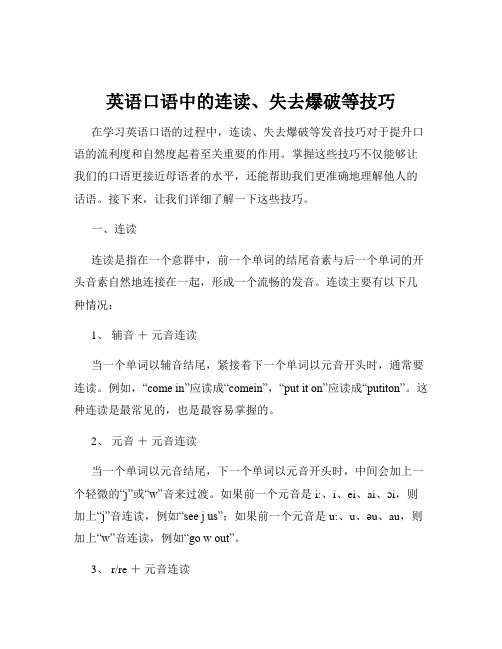
英语口语中的连读、失去爆破等技巧在学习英语口语的过程中,连读、失去爆破等发音技巧对于提升口语的流利度和自然度起着至关重要的作用。
掌握这些技巧不仅能够让我们的口语更接近母语者的水平,还能帮助我们更准确地理解他人的话语。
接下来,让我们详细了解一下这些技巧。
一、连读连读是指在一个意群中,前一个单词的结尾音素与后一个单词的开头音素自然地连接在一起,形成一个流畅的发音。
连读主要有以下几种情况:1、辅音+元音连读当一个单词以辅音结尾,紧接着下一个单词以元音开头时,通常要连读。
例如,“come in”应读成“comein”,“put it on”应读成“putiton”。
这种连读是最常见的,也是最容易掌握的。
2、元音+元音连读当一个单词以元音结尾,下一个单词以元音开头时,中间会加上一个轻微的“j”或“w”音来过渡。
如果前一个元音是i:、i、ei、ai、ɔi,则加上“j”音连读,例如“see j us”;如果前一个元音是u:、u、əu、au,则加上“w”音连读,例如“go w out”。
3、 r/re +元音连读如果单词以 r 或 re 结尾,后接一个以元音开头的单词,此时 r 要发音,并与后面的元音连读。
例如,“for ever”应读成“forever”,“here and there”应读成“hereandthere”。
连读的好处在于能够使句子的发音更加流畅,减少停顿,增强语言的节奏感。
但需要注意的是,连读并不是随意的,而是要根据单词的发音和句子的语境来决定。
二、失去爆破失去爆破是指在某些情况下,爆破音(/p/、/b/、/t/、/d/、/k/、/g/)在发音时只做出发音的准备,但不爆破出来,稍作停顿后直接发出后面的音。
失去爆破主要有以下几种情况:1、爆破音+爆破音当两个爆破音相邻时,前一个爆破音失去爆破。
例如,“big cake”中,“big”的“g”失去爆破,只读“bi_ cake”;“stop talking”中,“stop”的“p”失去爆破,只读“sto_ talking”。
英语口语连读技巧和规律

英语口语连读技巧和规律口语连读是英语口语中的一种重要技巧,是指在说话过程中,将两个或多个单词连在一起,形成一个音节,使语音更加流畅自然。
对于英语学习者来说,掌握口语连读技巧和规律,不仅可以提高英语口语表达能力,还能加深对英语语音和语调的理解。
一、连读的基本原则1. 重读音节和非重读音节英语中有重读音节和非重读音节之分。
重读音节是在单词中发音最强烈的音节,而非重读音节则相对较弱。
在口语连读中,通常是将非重读音节的元音和辅音与相邻的重读音节的元音和辅音连读。
例如,单词“together”中,“to”和“gether”中的“o”、“e”、“r”可以连读成一个音节。
2. 元音和辅音的连读英语中的元音和辅音也有不同的连读规律。
元音通常与元音连读,辅音通常与辅音连读。
例如,单词“my egg”中,“my”和“egg”中的“y”、“e”可以连读成一个音节,“g”和“g”也可以连读成一个音节。
3. 词尾辅音和词首元音的连读在英语中,如果一个单词的词尾是辅音,而下一个单词的词首是元音,这时候通常会将两个单词的辅音和元音连读。
例如,“that cat”中,“t”和“c”可以连读成一个音节。
二、常见的口语连读1. 连读“t”和“y”在英语中,有些单词的结尾是“-ty”,如“twenty”、“thirty”、“forty”等,这时候通常会将“t”和“y”连读成一个音节,发音类似于“twenny”、“thirry”、“forry”等。
同样的规律也适用于形容词“pretty”和副词“already”等。
2. 连读“r”和元音在英语中,有些单词的结尾是“-er”,如“water”、“butter”、“better”等,这时候通常会将“r”和前面的元音连读成一个音节,发音类似于“wadder”、“budder”、“bedder”等。
同样的规律也适用于动词“enter”和名词“winter”等。
3. 连读“n”和“t”、“d”在英语中,有些单词的结尾是“-nt”或“-nd”,如“want”、“hand”、“sent”等,这时候通常会将“n”和“t”或“d”连读成一个音节,发音类似于“wan(t)”、“han(d)”、“sen(t)”等。
英语吞音连读弱读技巧和规律
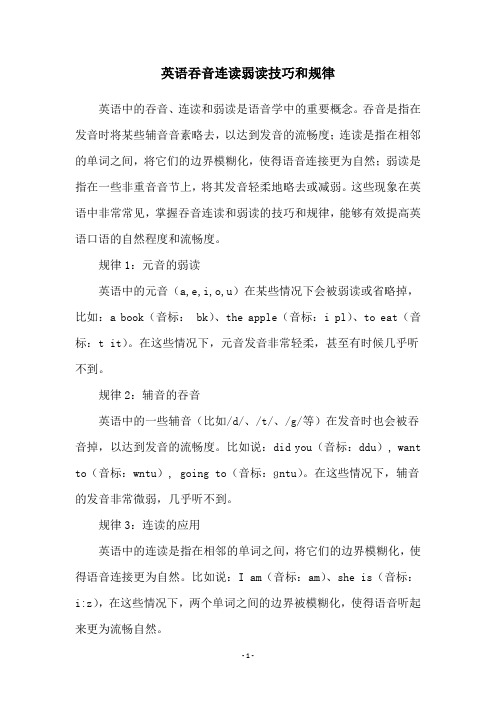
英语吞音连读弱读技巧和规律
英语中的吞音、连读和弱读是语音学中的重要概念。
吞音是指在发音时将某些辅音音素略去,以达到发音的流畅度;连读是指在相邻的单词之间,将它们的边界模糊化,使得语音连接更为自然;弱读是指在一些非重音音节上,将其发音轻柔地略去或减弱。
这些现象在英语中非常常见,掌握吞音连读和弱读的技巧和规律,能够有效提高英语口语的自然程度和流畅度。
规律1:元音的弱读
英语中的元音(a,e,i,o,u)在某些情况下会被弱读或省略掉,比如:a book(音标: bk)、the apple(音标:i pl)、to eat(音标:t it)。
在这些情况下,元音发音非常轻柔,甚至有时候几乎听不到。
规律2:辅音的吞音
英语中的一些辅音(比如/d/、/t/、/g/等)在发音时也会被吞音掉,以达到发音的流畅度。
比如说:did you(音标:ddu), want to(音标:wntu), going to(音标:ɡntu)。
在这些情况下,辅音的发音非常微弱,几乎听不到。
规律3:连读的应用
英语中的连读是指在相邻的单词之间,将它们的边界模糊化,使得语音连接更为自然。
比如说:I am(音标:am)、she is(音标:i:z),在这些情况下,两个单词之间的边界被模糊化,使得语音听起来更为流畅自然。
以上是英语中吞音连读弱读的技巧和规律,对于想要提高英语口语自然度和流畅度的人来说,掌握这些规律非常重要。
通过不断练习,将这些规律应用到实际口语练习中,可以有效地提高英语口语的水平。
连读弱读重读吞音技巧

连读弱读重读吞音技巧
1. 嘿,你知道吗?连读就像是词语们手牵手一起跑,让语言变得特别流畅。
比如“an apple”读成“a napple”。
2. 哇哦,弱读简直就是给某些词“减减肥”,让它们不那么突出但又必不可少呀!像“and I”可以读成“an’ I”。
3. 天呐,重读那可是在强调重点呢,就像给某个词画上大大的感叹号!比如说“Come HERE!”强调“here”。
4. 哎呀呀,吞音就像是偷偷吃掉了一个小声音,自然又有趣。
“I don’t know”有时候就会变成“I don’ know”。
5. 嘿呀,想象一下,连读不就是让词语们欢快地跳舞吗?“How are you”读成“How’re you”不就很带感嘛!
6. 哇塞,弱读就像给句子加了点柔和的滤镜呢,“of course”读成“ov course”是不是感觉更顺啦?
7. 哈哈,重读是不是就像highlight 一样呀,“That is MY book!”强调“my”多明显呀!
8. 咦,吞音不就是那种悄悄发生的小魔法么,“wanted to”变成“wan’ to”很奇妙吧?
总之,连读弱读重读吞音技巧可太有用啦,能让我们的口语变得超级棒!。
英语读音规则吞音连读
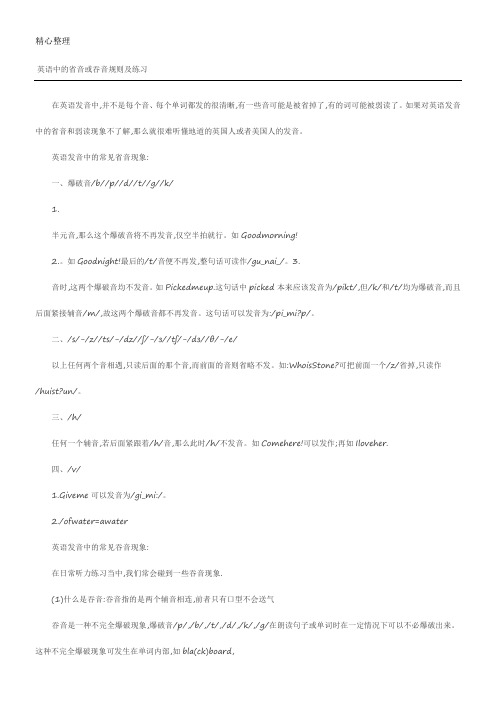
④爆破音后接/m/,/n/,/l/时,前面的爆破音失去爆破。如abi(t)moreexpensive等。我们需要注意的一个特例是,吞音时,一般情况下,鼻辅音不会被吞掉,因为“鼻形”做出时,鼻音已经被发出来了。
findit'stime.
Ihopetobeapartofyouagain,babyletusshine.
Moreexercises:
Thegirlinthere(d)coatwasonabla(ck)bikejus(t)now.Thebi(g)busfromthefa(c)toryisfullofpeople.
英语中的省音或吞音规则及练习
在英语发音中,并不是每个音、每个单词都发的很清晰,有一些音可能是被省掉了,有的词可能被弱读了。如果对英语发音中的省音和弱读现象不了解,那么就很难听懂地道的英国人或者美国人的发音。
英语发音中的常见省音现象:
一、爆破音/b//p//d//t//g//k/
1.
半元音,那么这个爆破音将不再发音,仅空半拍就行。如Goodmorning!
Wha(t)timedoeshegetupeverymorning?
Thisisanol(d)pi(c)tureofabi(g)car.
Theol(d)do(c)torhasaca(t),too.
We’regoingtoworkonafarmnex(t)Tuesday.
Whatwouldyoulike,ho(t)teaorbla(ck)coffee?
It’saverycol(d)day,butit’sagoo(d)day.
Youcanputi(t)downinthebi(g)garden.
英语的连读、吞音技巧
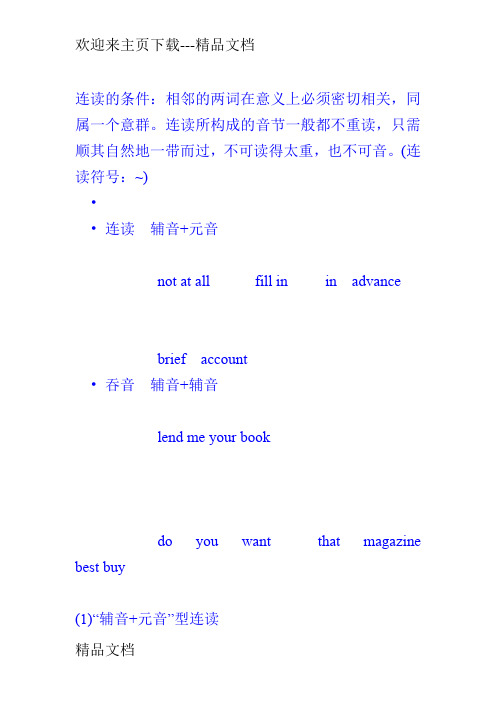
连读的条件:相邻的两词在意义上必须密切相关,同属一个意群。
连读所构成的音节一般都不重读,只需顺其自然地一带而过,不可读得太重,也不可音。
(连读符号:~)••连读辅音+元音not at all fill in in advancebrief account•吞音辅音+辅音lend me your bookdo you want that magazine best buy(1)“辅音+元音”型连读在同一个意群里,如果相邻两词中的前一个词是以辅音结尾,后一个词是以元音开头,这就要将辅音与元音拼起来连读。
I’m~an~English boy.It~is~an~old book.Let me have~a look~at~it.Ms Black worked in~an~office last~yesterday.I called~you half~an~hour~ago.Put~it~on, please.Not~at~all.Please pick~it~up.(2)“r/re+元音”型连读如果前一个词是以-r或者-re结尾,后一个词是以元音开头,这时的r或re不但要发/r/,而且还要与后面的元音拼起来连读。
They’re my father~and mother.I looked for~it here~and there.There~is a football under~it.There~are some books on the desk.Here~is a letter for you.Here~are four~eggs.But where~is my cup?Where~are your brother~and sister?但是,如果一个音节的前后都有字母r,即使后面的词以元音开头,也不能连读。
The black clouds are coming nearer and nearer.(nearer 与and不可连读)(3)“辅音+半元音”型连读英语语音中的/j/和/w/是半元音,如果前一个词是以辅音结尾,后一个词是以半元音,特别是/j/开头,此时也要连读。
英语发音连读规则英语口语技巧

英语发音连读规则英语口语技巧一、英语发音连读规则:1.辅音连读:辅音连读指的是在两个单词之间,当一个以辅音结尾,下一个单词以元音开头时,这两个辅音可以连在一起发音。
例如, "take an apple"(拿一个苹果)中的"n"和"a"可以连在一起发音,变成"takən apple"。
2.元音连读:元音连读指的是当两个单词之间有两个元音时,这两个元音可以连在一起发音。
例如, "see it"(看到它)中的"e"和"i"可以连在一起发音,变成"siːt"。
3.元音省略:元音省略是指当一个单词以元音结尾,下一个单词以元音开头时,第一个单词的结尾元音可以省略。
例如, "go out"(出去)中的"o"可以省略,变成"gəʊut"。
二、英语口语技巧:1.语调:语调是说话时声音上升和下降的模式,它可以增强我们的语言表达力。
在英语口语中,语调通常在重读单词上上升,然后下降。
这种上升和下降的语调可以帮助我们加强语气,使我们的表达更具说服力。
2.重读:重读是指在一连串的单词中,给一些特定单词加重音,以使这些单词更突出。
在英语中,通常将重点放在名词、动词和形容词上。
例如, "I want a green apple"(我想要一个绿色的苹果)中的"want"和"green"就是重读的单词。
3.连贯:在英语口语中,连贯是指在不同的句子和段落之间保持流畅的过渡。
为了实现连贯,我们可以使用一些过渡词和短语,例如"however"(然而)、"in addition"(此外)和"on the other hand"(另一方面)。
英语中的连读规则 总结

英语中的连读规则总结
英语中的连读规则主要涉及两个方面:辅音与元音的连读,以及词尾辅音与词首元音或半元音的连读。
在辅音与元音的连读中,如果前一个词以辅音结尾,后一个词以元音开头,那么辅音和元音可以连读。
例如,“s+a”时,s前面的部分单独发音,s跟后面的部分一起发音。
另外,如果前一个词以y或e结尾,后面的元音需要补上y,这个规则就是将y的读音拖长了。
如果前一个词以o或ow结尾,后面的元音需要补上w。
在词尾辅音与词首元音或半元音的连读中,如果短语或句子中相邻的词前一个词的末尾是辅音,后一个词的词首是元音或半元音,那么这两个词就可以连读。
这种连读通常发生在有实际内容的实义词和语法性的词之间,单词组合在一起意思关联较大才连读。
例如,“post_office”可以连读为“post_office”,“first_avenue”可以连读为“first_avenue”。
另外,“/r/、/l/、/n/、/m/、/ŋ/”这五个辅音与元音连读时,感觉像读了两遍,其实是由于语速慢了。
在意群之间有停顿时,两个短语或两个从句间相邻的音不连读。
以上是英语中的连读规则,仅供参考,建议查阅英语语音书籍获取更全面和准确的信息。
英语的连读吞音技巧

英语的连读吞音技巧英语的连读吞音技巧 Pleasure Group Office【T985AB-B866SYT-B182C-BS682T-STT18】连读的条件:相邻的两词在意义上必须密切相关,同属一个意群。
连读所构成的音节一般都不重读,只需顺其自然地一带而过,不可读得太重,也不可音。
(连读符号:~)•连读辅音+元音not at all fill in in advancebrief account•吞音辅音+辅音lend me your bookdo you want that magazinebest buy(1)“辅音+元音”型连读在同一个意群里,如果相邻两词中的前一个词是以辅音结尾,后一个词是以元音开头,这就要将辅音与元音拼起来连读。
I’m~an~En glish boy.It~is~an~old book.Let me have~a look~at~it.Ms Black worked in~an~office last~yesterday.I called~you half~an~hour~ago.Put~it~on, please.Not~at~all.Please pick~it~up.(2)“r/re+元音”型连读如果前一个词是以-r或者-re结尾,后一个词是以元音开头,这时的r或re不但要发/r/,而且还要与后面的元音拼起来连读。
They’re my father~and mother.I looked for~it here~and there.There~is a football under~it.There~are some books on the desk.Here~is a letter for you.Here~are four~eggs.But where~is my cupWhere~are your brother~and sister但是,如果一个音节的前后都有字母r,即使后面的词以元音开头,也不能连读。
英语中的连读、弱读、缩读规则(附音标)

英语中的连读、弱读、缩读规则(附音标)英语中地道的发音离不开连读、弱读和缩读等技巧,要掌握这些规则,看完这一篇就可以了。
连读规则一、辅音+元音如果一个单词的最后一个音是辅音,后面单词的第一个音是元音,这个时候辅音和元音合在一起读成一个音,就好像读成一个单词一样。
比如常见的辅音:1.【s】lots of 辅音在前,元音在后,就可以连读[lɑːtsʌv]2.辅音【m】come on 连读为[kʌmɑːn]3.辅音【n】an hour 连读为[ænˈaʊər] (hour 的h 不发音)4.辅音【t】get up 连读为[ɡetʌp]5.辅音【p】keep off 连读为[kiːpɔːf]6.辅音【r】far away 连读为[fɑːrəˈweɪ]7.辅音【l】all of连读为[ɔːlʌv]8.辅音【z】was it 连读为[wʌzɪt]综合短语练习put it off 连读为[pʊt ˆɪt ˆɔːf]pick it up 连读为[pɪk ˆɪt ˆʌp]get out of 连读为[ɡet ˆaʊt ˆʌv]haveˆa lookˆatˆit 连读为[hæv ˆəlʊk ˆæt ˆɪt]I look forˆit hereˆand there.连读为[aɪlʊk fɔːr ˆɪt hɪr ˆænd ðer]二、辅音+辅音前一个单词的结尾辅音和后面一个单词开始的辅音相同,只发一次音。
这种情况通常发生在辅音[t][d][k][g][b][p]等辅音出现的时候。
1.first time(t+t),first后面发的是[t],time 第一个音发的也是[t],两个[t]碰到一起,完全一样,两个[t]就只读一次。
2.great teacher(t+t),其中great的尾音[t]和teacher 的前音[t]相同,那么前一个t不发音。
3.take care(k+k)最后一个音发[k],care 第一个字母发[k],两个[k]读成一个[k],读成ta care。
英语的吞音连读技巧

英语的吞音连读技巧1.吞音:吞音是指在英语中,有些辅音音素在发音时会被省略或模糊。
常见的吞音有以下几种:- T吞音:在英语中,后面紧跟着辅音的/t/音素(如cat)通常会被吞音,发音时类似于普通的/d/音素。
如在"What are you doing?"中,会发音为/wɒdʒəduːɪŋ/,而不是/wɒt ɑː juː duːɪŋ/。
- D吞音:和T吞音类似,紧跟着辅音的/d/音素在发音时也会被吞音。
如在"good day"中,会发音为/ɡʊdeɪ/,而不是/ɡʊd deɪ/。
- G吞音:当单词以字母"g"结尾,后面紧跟着辅音时,这个"g"会被吞音。
如在"go home"中,会发音为/ɡəʊ həʊm/,而不是/ɡəʊ ɡoʊm/。
吞音的掌握需要通过大量的听力练习和模仿来提高,可以多听原生口语者的对话和录音,注意观察和模仿他们的发音。
2.连读:连读是指英语中的词与词之间,在连续语音中出现发音上的变化。
主要的连读方式有以下几种:- 连读的弱读:很多虚词(如and, of, to, for等)在连读时会发生弱读现象。
弱读是指音量、语气和重音的部分或完全丧失,发音模糊不清。
例如,"I am going to the store"中,"going to"在连读时会发音为/gəʊnə/,而不是独立发音为/gəʊɪntuː/。
- 连读的浊化:有些辅音在连读时会发生浊化现象。
例如,连读的词组"have to"会浊化成/hæftə/,而不是/hæv tuː/。
- 连读的元音变化:在连读时,两个词之间的元音可能会发生变化,以便更顺畅地连接起来。
例如,连读的词组"yes it is"会发音为/"jezɪts/,而不是独立发音为/"jes ɪt ɪz/。
英语口语连读技巧和规律
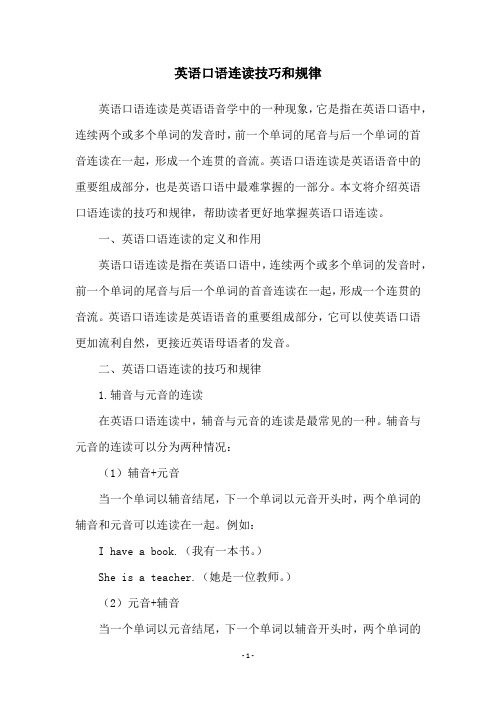
英语口语连读技巧和规律英语口语连读是英语语音学中的一种现象,它是指在英语口语中,连续两个或多个单词的发音时,前一个单词的尾音与后一个单词的首音连读在一起,形成一个连贯的音流。
英语口语连读是英语语音中的重要组成部分,也是英语口语中最难掌握的一部分。
本文将介绍英语口语连读的技巧和规律,帮助读者更好地掌握英语口语连读。
一、英语口语连读的定义和作用英语口语连读是指在英语口语中,连续两个或多个单词的发音时,前一个单词的尾音与后一个单词的首音连读在一起,形成一个连贯的音流。
英语口语连读是英语语音的重要组成部分,它可以使英语口语更加流利自然,更接近英语母语者的发音。
二、英语口语连读的技巧和规律1.辅音与元音的连读在英语口语连读中,辅音与元音的连读是最常见的一种。
辅音与元音的连读可以分为两种情况:(1)辅音+元音当一个单词以辅音结尾,下一个单词以元音开头时,两个单词的辅音和元音可以连读在一起。
例如:I have a book.(我有一本书。
)She is a teacher.(她是一位教师。
)(2)元音+辅音当一个单词以元音结尾,下一个单词以辅音开头时,两个单词的元音和辅音可以连读在一起。
例如:He is a good boy.(他是个好孩子。
)I am going to school.(我要去学校。
)2.连续辅音的连读在英语口语连读中,连续辅音的连读是指两个或多个辅音连读在一起。
连续辅音的连读可以分为两种情况:(1)相同辅音当两个单词相邻的辅音相同时,可以将它们连读在一起。
例如: big girl(大女孩)red dog(红狗)(2)不同辅音当两个单词相邻的辅音不同时,可以在它们之间加入一个短音,然后将它们连读在一起。
例如:last time(上次)best friend(最好的朋友)3.连续元音的连读在英语口语连读中,连续元音的连读是指两个或多个元音连读在一起。
连续元音的连读可以分为两种情况:(1)相同元音当两个单词相邻的元音相同时,可以将它们连读在一起。
英语中浊化、连读、吞音该怎么学?
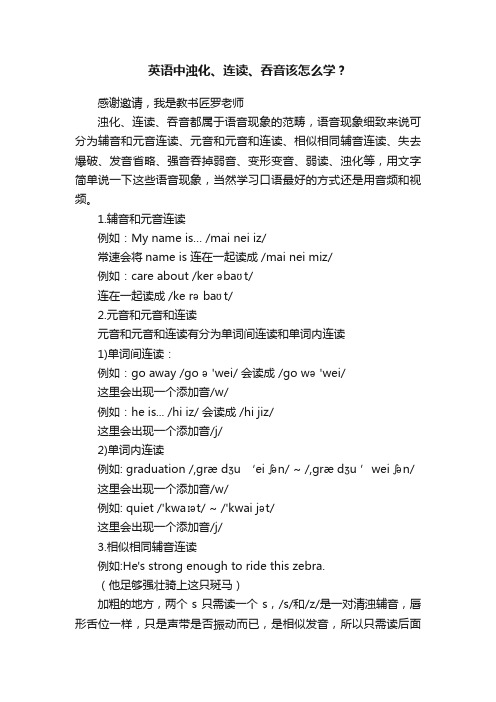
英语中浊化、连读、吞音该怎么学?感谢邀请,我是教书匠罗老师浊化、连读、吞音都属于语音现象的范畴,语音现象细致来说可分为辅音和元音连读、元音和元音和连读、相似相同辅音连读、失去爆破、发音省略、强音吞掉弱音、变形变音、弱读、浊化等,用文字简单说一下这些语音现象,当然学习口语最好的方式还是用音频和视频。
1.辅音和元音连读例如:My name is… /mai nei iz/常速会将name is 连在一起读成 /mai nei miz/例如:care about /ker əbaʊt/连在一起读成 /ke rə baʊt/2.元音和元音和连读元音和元音和连读有分为单词间连读和单词内连读1)单词间连读:例如:go away /go ə 'wei/ 会读成 /go wə 'wei/这里会出现一个添加音/w/例如:he is... /hi iz/ 会读成 /hi jiz/这里会出现一个添加音/j/2)单词内连读例如: graduation /,ɡræ dʒu ‘ei ʃən/ ~ /,ɡræ dʒu ’wei ʃən/ 这里会出现一个添加音/w/例如: quiet /'kwaɪət/ ~ /'kwai jət/这里会出现一个添加音/j/3.相似相同辅音连读例如:He's strong enough to ride this zebra.(他足够强壮骑上这只斑马)加粗的地方,两个s只需读一个s,/s/和/z/是一对清浊辅音,唇形舌位一样,只是声带是否振动而已,是相似发音,所以只需读后面的/z/,前面的/s/省略。
当然相似相同的不止这些音,详尽的内容在我今日头条专栏里可以查看4.失去爆破例如:sit down /sɪt daʊn/ ~ /sɪ daʊn/ 这里的/t/发生失爆例如:good job /ɡʊd dʒɑb/ ~/ɡʊ dʒɑb/ 这里的/d/发生失爆失去爆破只做口型不发声,有时候会有声音,但也基本听不到5.强音吞掉弱音例如:important /ɪm'pɔrtnt/ 这里的/n/是个强音,/t/是弱音,当强音挨着弱音,强音就会吞掉弱音,也就是弱音不发音,实际发音为 /ɪm’pɔr n/当然强音不止/n/,弱音不止/t/,详尽的内容在我今日头条专栏里可以查看,在强调一遍,这里只是举一些例子,让大家有个基本认知,毕竟只看文字是学不好的口语的。
- 1、下载文档前请自行甄别文档内容的完整性,平台不提供额外的编辑、内容补充、找答案等附加服务。
- 2、"仅部分预览"的文档,不可在线预览部分如存在完整性等问题,可反馈申请退款(可完整预览的文档不适用该条件!)。
- 3、如文档侵犯您的权益,请联系客服反馈,我们会尽快为您处理(人工客服工作时间:9:00-18:30)。
英语的连读吞音技巧集团文件发布号:(9816-UATWW-MWUB-WUNN-INNUL-DQQTY-
连读的条件:相邻的两词在意义上必须密切相关,同属一个意群。
连读所构成的音节一般都不重读,只需顺其自然地一带而过,不可读得太重,也不可音。
(连读符号:~)
•连读辅音+元音
not at all fill in in advance
brief account
•吞音辅音+辅音
lend me your book
do you want that magazine
best buy
(1)“辅音+元音”型连读
在同一个意群里,如果相邻两词中的前一个词是以辅音结尾,后一个词是以元音开头,这就要将辅音与元音拼起来连读。
I’m~an~English boy.
It~is~an~old book.
Let me have~a look~at~it.
Ms Black worked in~an~office last~yesterday.
I called~you half~an~hour~ago.
Put~it~on, please.
Not~at~all.
Please pick~it~up.
(2)“r/re+元音”型连读
如果前一个词是以-r或者-re结尾,后一个词是以元音开头,这时的r 或re不但要发/r/,而且还要与后面的元音拼起来连读。
They’re my father~and mother.
I looked for~it here~and there.
There~is a football under~it.
There~are some books on the desk.
Here~is a letter for you.
Here~are four~eggs.
But where~is my cup?
Where~are your brother~and sister?
但是,如果一个音节的前后都有字母r,即使后面的词以元音开头,也不能连读。
The black clouds are coming nearer and nearer.(nearer与and不可连读)
(3)“辅音+半元音”型连读
英语语音中的/j/和/w/是半元音,如果前一个词是以辅音结尾,后一个词是以半元音,特别是/j/开头,此时也要连读。
Thank~you.
Nice to meet~you.
Did~you get there late~again?
Would~you like~a cup~of tea
Could~you help me, please?
“音的同化”
—常把/d/+/j/读成/dV/,did you听上成了/dIdVu/,would you成了
/wudVu/,could you成了/kudVu/。
(4)“元音+元音”型连读如果前一个词以元音结尾,后一个词以元音开头,这两个音往往也要自然而不间断地连读到一起。
I~am Chinese.
He~is very friendly to me.
She wants to study~English.
How~and why did you come here?
She can’t carry~it.
It’ll take you three~hours to walk t here.
The question is too~easy for him to answer.
(5)当短语或从句之间按意群进行停顿时,意群与意群之间即使有两个相邻的辅音与元音出现,也不可连读。
Is~it a~hat or a cat?(hat与or之间不可以连读)
There~is~a good book in my desk. (book与in之间不可以连读)Can you speak~English or French? (English与or之间不可以连读)Shall we meet at~eight or ten tomorrow morning? (meet与 at,eight与or之间不可以连读)
She opened the door and walked~in. (door与and之间不可以连读)失去爆破6个爆破音有3对/p/,/b/,/t/,/d/,/k/,/g/
失去爆破,又叫不完全爆破,就是在某些情况下,只须做出发音的准备,但并不发音,稍稍停顿后就发后面的音。
(1)“爆破音+爆破音”型
6个爆破音【t、d、k、g、p、b】中的任意2个相临时,前一个爆破音会失去爆破,即由相关的发音器官做好这个发音的姿势,稍做停顿后即发后面的爆破音。
The girl in the re(d) coat was on a bla(ck) bike jus(t) now. The bi(g) bus from the fa(c) tory is full of people.
Wha(t) time does he get up every morning?
This is an ol(d) pi(c)ture of a bi(g) car.
The ol(d) do(c)tor has a ca(t), too.
We’re going to work on a farm nex(t) Tuesday.
What would you like, ho(t) tea or bla(ck) coffee?
It’s a very col(d) day, but it’s a goo(d) day.
You can put i(t) down in the bi(g) garden.
I bought a chea(p) book, but it’s a goo(d) book.
(2)“爆破音+摩擦音”型如果前面是爆破音,其后紧跟着某些摩擦音(如/f/,/s/,/W/,/T/等),那么前面那个爆破音仅有十分轻微的爆破,而后面那个摩擦音则要完全爆破。
6个爆破音有3对/p/,/b/,/t/,/d/,/k/,/g/失去爆破,又叫不完全爆破,就是在某些情况下,只须做出发音的准备,但并不发音,稍稍停顿后就发后面的音。
(1)“爆破音+爆破音”型6个爆破音中的任意2个相临时,前一个爆破音会失去爆破,即由相关的发音器官做好这个发音的姿势,稍做停顿后即发后面的爆破音。
The girl in the re(d) coat was on a bla(ck) bike jus(t) now. The bi(g) bus from the fa(c) tory is full of people.
Wha(t) time does he get up every morning?
This is an ol(d) pi(c)ture of a bi(g) car.
The ol(d) do(c)tor has a ca(t), too.
We’re going to work on a farm nex(t) Tue sday.
What would you like, ho(t) tea or bla(ck) coffee?
It’s a very col(d) day, but it’s a goo(d) day.
You can put i(t) down in the bi(g) garden.
I bought a chea(p) book, but it’s a goo(d) book.
(2)“爆破音+摩擦音”型如果前面是爆破音,其后紧跟着某些摩擦音(如/f/,/s/,/W/,/T/等),那么前面那个爆破音仅有十分轻微的爆破,而后面那个摩擦音则要完全爆破。
Goo(d) morning, Mr. Bell.
Goo(d) morning, dear.
Uncle Li’s fa(c)tory is qui(te) near to the cinema.
I wen(t) there alone a(t) nine las(t) night.
-Do you know his bi(ke) number? -Sorry, I don’(t) know.
The forty-firs(t) lesson is qui(te) difficult.
Goo(d) luck, Lin Tao.
爆破音+m/n,爆破音也会失爆!
/p/, /t/, /k/开头的音节发 /b/, /d/, /g/
在背诵新东方80篇,总结出来的一点东西:
1. 音标中无重读音节的,要轻轻的读,不要读出有高低调的声音!不要老爱把音节读成渐高调,感觉有点歇斯底里,很难听的!
2. 重音且长音要尽量拖长,发音要饱满,但是[i:]除外,这个音节只需轻轻带过!
ee、啊:、呃:读起来让人听着这个音节很明显。
3. 短音的i有时候不发音,只起到一个连接的作用;。
